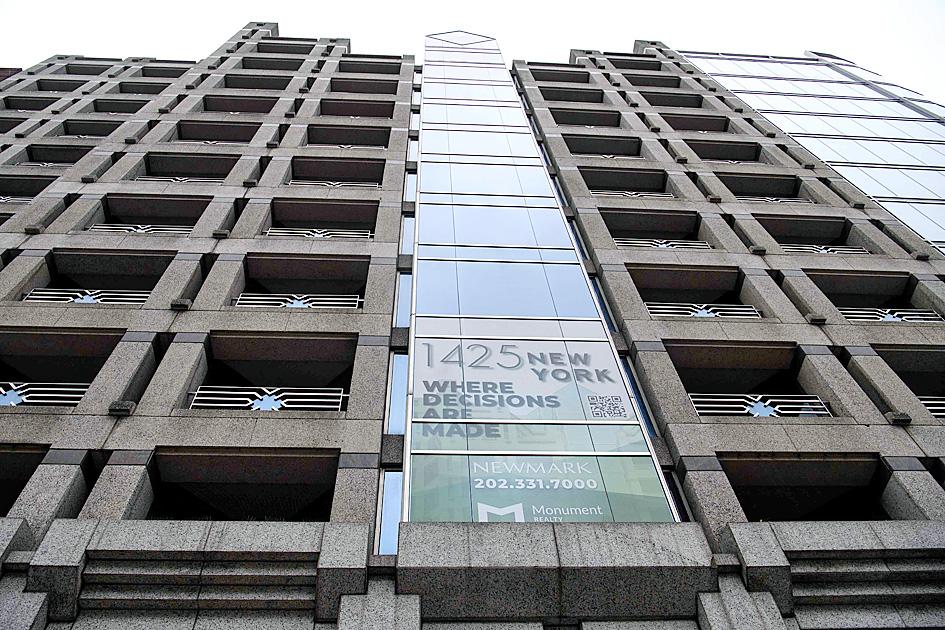Blocks from the White House, an unassuming edifice in downtown Washington that once held offices used by the US Department of Justice is set to be converted into homes for hundreds of people.
The transformation of the vacant office space is among a surge of “adaptive reuse” projects that swept the US property market last year, with developers buying hotels and offices that were struggling to get business and announcing plans to turn them into apartments.
“The market spoke, and it said the value was greater for a conversion than for it continuing as office space,” said Michael Abrams, managing director of Foulger-Pratt, the property development firm that is turning the 14-story building on New York Avenue into 255 apartments.

Photo: AFP
A survey by apartment listing service RentCafe found that about 20,100 apartments were built out of converted properties in the US last year, almost double the number converted in 2020.
Such conversions could offer a way forward for US downtowns, which have not been the same since office workers fled as the COVID-19 pandemic started nearly two years ago, leaving landlords and local businesses struggling.
“The slow office market recovery is just going to make it that much more expensive to carry vacant office buildings,” Abrams said.
Conversions might also play a role in easing a shortage of affordable housing, particularly in cities like Washington, where notoriously high rents are a feature of life.
“From the overall perspective, we just need increased supply. By having more supply, both the home price growth will come down and the rents will come down,” National Association of Realtors chief economist Lawrence Yun said.
Despite the downturn caused by COVID-19, the median price of existing homes climbed 15.8 percent over the course of the past year, and by last month supply had hit an all-time low, likely exacerbating a crisis of affordable housing that predated the pandemic, association data showed.
Meanwhile, the US has a glut of offices. With many of them dating to the 1980s, they are now too old to be attractive to companies, said Tracy Hadden Loh, a fellow at the Brookings Institution.
With their designs centered around outdated needs like space for file cabinets, “really just the entire building is obsolete,” she said in an interview.
Marc Ehrlich, chief investment officer at Rose Associates, which has converted New York City offices into housing, said such projects tend to be “well-located properties that need a higher and better use.”
One of his firm’s latest undertakings is the transformation of an office once used by telecommunications firm AT&T into a place people want to live.
Lacking amenities such as covered parking, the building is unlikely to attract commercial tenants, Ehrlich said.
However, the new apartments would feature coworking spaces, as many tenants would likely want to continue working from home, he said.
In Washington, developers are pouncing on properties formerly rented by the region’s top employer, the US government.
This includes The Wray, an office building used by the US Department of State, but which has been totally renovated to house apartments.
The only signs of its former use are in the lobby, where the tiles are original, as is a directory listing the names of state department offices once based there.
“The pool of tenants that goes back into these buildings is dramatically diminished,” Adams said. “That’s what’s putting the stress on that tier of property, that’s what’s creating the opportunity.”

Incumbent Ecuadoran President Daniel Noboa on Sunday claimed a runaway victory in the nation’s presidential election, after voters endorsed the young leader’s “iron fist” approach to rampant cartel violence. With more than 90 percent of the votes counted, the National Election Council said Noboa had an unassailable 12-point lead over his leftist rival Luisa Gonzalez. Official results showed Noboa with 56 percent of the vote, against Gonzalez’s 44 percent — a far bigger winning margin than expected after a virtual tie in the first round. Speaking to jubilant supporters in his hometown of Olon, the 37-year-old president claimed a “historic victory.” “A huge hug

Two Belgian teenagers on Tuesday were charged with wildlife piracy after they were found with thousands of ants packed in test tubes in what Kenyan authorities said was part of a trend in trafficking smaller and lesser-known species. Lornoy David and Seppe Lodewijckx, two 19-year-olds who were arrested on April 5 with 5,000 ants at a guest house, appeared distraught during their appearance before a magistrate in Nairobi and were comforted in the courtroom by relatives. They told the magistrate that they were collecting the ants for fun and did not know that it was illegal. In a separate criminal case, Kenyan Dennis

A judge in Bangladesh issued an arrest warrant for the British member of parliament and former British economic secretary to the treasury Tulip Siddiq, who is a niece of former Bangladeshi prime minister Sheikh Hasina, who was ousted in August last year in a mass uprising that ended her 15-year rule. The Bangladeshi Anti-Corruption Commission has been investigating allegations against Siddiq that she and her family members, including Hasina, illegally received land in a state-owned township project near Dhaka, the capital. Senior Special Judge of Dhaka Metropolitan Zakir Hossain passed the order on Sunday, after considering charges in three separate cases filed

APPORTIONING BLAME: The US president said that there were ‘millions of people dead because of three people’ — Vladimir Putin, Joe Biden and Volodymyr Zelenskiy US President Donald Trump on Monday resumed his attempts to blame Ukrainian President Volodymyr Zelenskiy for Russia’s invasion, falsely accusing him of responsibility for “millions” of deaths. Trump — who had a blazing public row in the Oval Office with Zelenskiy six weeks ago — said the Ukranian shared the blame with Russian President Vladimir Putin, who ordered the February 2022 invasion, and then-US president Joe Biden. Trump told reporters that there were “millions of people dead because of three people.” “Let’s say Putin No. 1, but let’s say Biden, who had no idea what the hell he was doing, No. 2, and